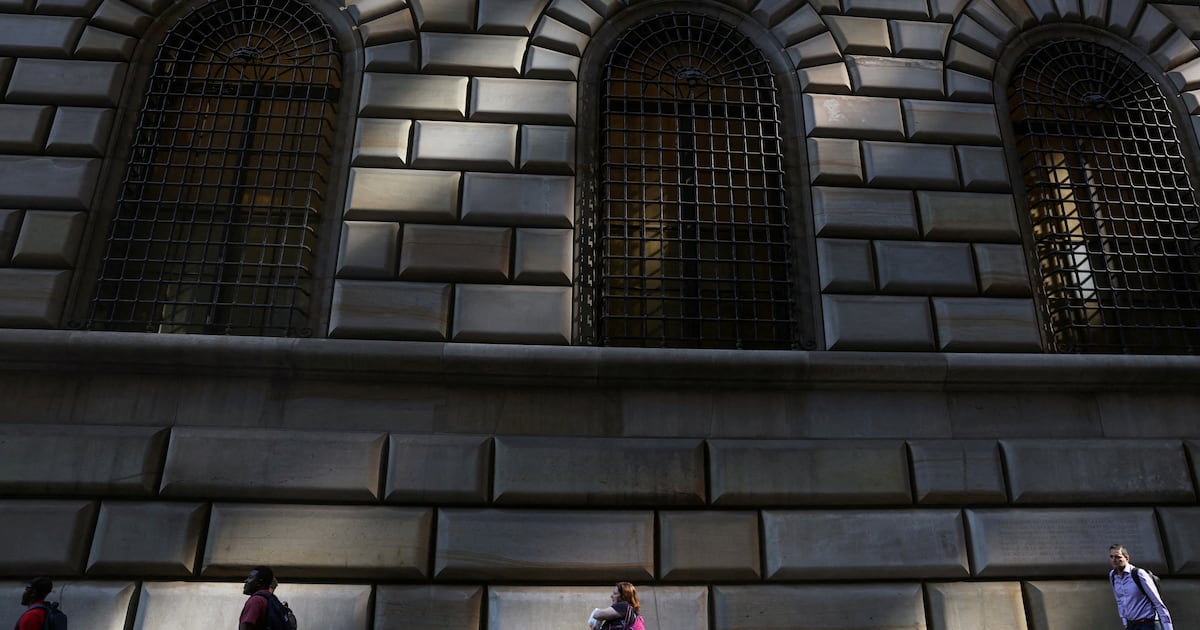Uncertainty over US President Donald Trump‘s policies loomed over a New York Fed conference on the US dollar last week, as the White House’s unconventional tariff agenda and efforts to exert control over the central bank’s board have led to greater scrutiny on the world’s reserve currency.
Just a stone’s throw from Wall Street, the Federal Reserve Bank of New York is a major player in the global financial system. The New York Fed, which implements the monetary policy decided on by the US central bank’s rate-setting committee, provides services to more than 200 account holders, including foreign central banks.
The New York Fed also serves as a global custodian of gold on behalf of the US government and foreign central banks, among other account holders. The gold vault, situated about 25 metres below the building in Manhattan’s financial district, stores roughly 507,000 gold bars, which had a combined weight of 6,331 tonnes as of 2024.
The US dollar plays a critical role in shaping global investment goals because of its status as the world’s financial currency and because of foreign investment into the US.
“The sad reality is that many people across the world are at least questioning whether the institutional strengths that gave the dollar its primacy in the first place are still intact,” said Daleep Singh, a former official in president Joe Biden’s administration.
A series of Mr Trump’s manoeuvres this year have weighed on the dollar. The ICE dollar index, which measures the greenback against a basket of six major rivals, has fallen more than 9 per cent amid the President’s wide-ranging tariff agenda and his efforts to reshape the Fed’s board of governors in Washington.
So far those efforts – which include placing a top economic ally on the Fed board and seeking the removal of a governor on mortgage fraud allegations – have done little to persuade the Federal Reserve to cut rates aggressively.
Projections last week showed the Fed expects to cut interest rates by an additional 50 basis points this year after lowering rates by 25 basis points last week, which would bring the effective federal funds rate down to about 3.6 per cent by the end of this year.
That falls well short of the 3 per cent reduction Mr Trump has demanded. Only Stephen Miran, a newly confirmed Fed governor and a top economic ally of the President, has argued for steep cuts.
Mr Trump this year has frequently directed his anger at Fed Chair Jerome Powell. Tension between the two came to a head in July when Mr Trump made an near precedent-shattering visit to the Fed’s headquarters after complaining over alleged cost overruns related to the central bank’s renovation project.
With Mr Powell’s term as Fed chair due to expire in May, Mr Trump will have an opportunity to nominate a successor more inclined to push for large rate cuts.
Mr Singh, now vice chair and chief global economist at PGIM, warned that this could lead to a “tale of two Feds” next year.
“We do worry quite a bit about … an abruptly dovish shift in the Fed’s reaction function going into next year,” he said.
Most economists hold the Fed’s independence as sacrosanct and argue it plays a crucial role in the global financial stability and the role of the US dollar as the world’s reserve currency. That independence has endured considerable strain this year, and an expected Supreme Court ruling on the fate of embattled Fed governor Lisa Cook could have huge ramifications for the global economy.
“Confidence in a currency depends on some trustworthy institutions that stand behind it,” Jeffry Frieden, a professor at Columbia University, said during a panel session.
In the face of a politically motivated Fed, Mr Singh said other central banks would have incentive not to move in lockstep with the US, to protect their own credibility.
“So on a cyclical basis, I think the risks to the dollar are skewed to the downside,” he said.
While other major central banks including the Bank of England and European Central Bank have gone through a series of rate cuts, the Fed has operated cautiously due to the uncertain effects that Mr Trump’s tariffs could have on the economy.
Fed officials thus far broadly anticipate those tariffs will lead to a one-time price increase.
The dollar index fell following the so-called Liberation Day announcement on April 2 and has fluctuated amid Mr Trump’s stop-start approach. It was trading at 98.18 on Friday, a year-to-date decline of 9.5 per cent.
“That wasn’t part of the script,” said Mahmood Pradhan, head of global macroeconomics at the Amundi Institute.
Growing US federal government debt is also weighing on the dollar. Last week, Bridgewater founder Ray Dalio warned excessive US government borrowing is unsustainable and the country is facing a significant fiscal crisis that will place at risk its standing in the monetary order.
Experts say there is currently no suitable rival to supplant the US dollar as the world’s reserve currency.
Still it is a question that investors in Europe, Asia and the Middle East ask, Mr Pradhan said. The challenge is to understand what they are doing about it.
“And that’s really the puzzle,” Mr Pradhan said.
